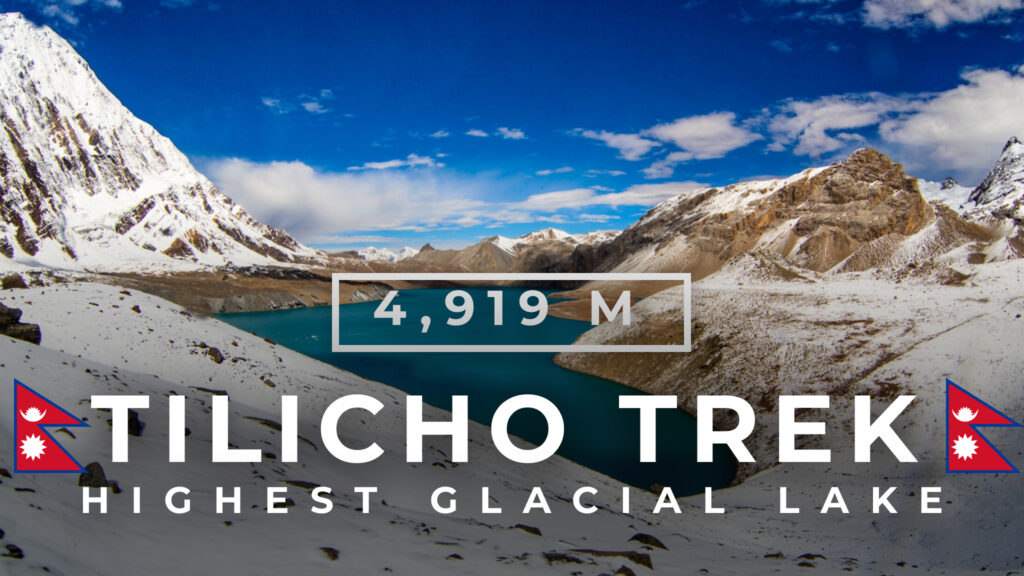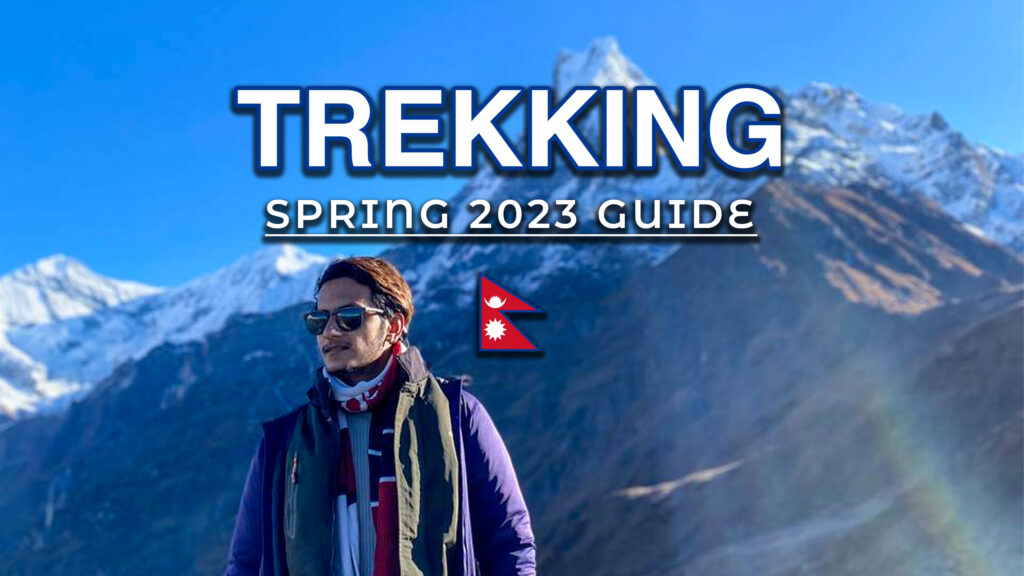Tilicho Lake Trek Highlights
- Take a drive between Kathmandu and Pokhara, experiencing the beautiful roads and local culture along the way.
- Walk along the Marshyangdi River valley.
- Meet and get to know the mountain communities in the Himalayas.
- Witness views of some of the world’s highest peaks: Dhaulagiri I, Manaslu, and Annapurna I.
- Trek to Tilicho Lake, the highest lake in the world.
- Visit the old Buddhist monastery in Braga.
Trek Attributes
- Max Elevation: 4,920 meters (Tilicho Lake)
- Min Elevation: 1,100 meters (Syange)
- No. of Days: 12 days
- Level of Difficulty: Challenging
- Best Season: March to May, September to November
- Accommodation: Teahouses and lodges
- Budget: Approximately NPR 35,000 to NPR 40,000
Tilicho Lake Trek Overview
The Tilicho Lake Trek takes you to Tilicho Lake, sitting at 5,200 meters. It’s among the highest lakes in the world.
You will leave Kathmandu in a private tourist vehicle to Syange. The drive takes about 7 to 9 hours, depending on road conditions and traffic. The trek starts from Syange, following the Marshyangdi River, with views of Manaslu and Himal Chuli to the east.
This trek leads you through beautiful villages with diverse ethnic groups, offering great views of the Himalayas. The route is a modified version of the Annapurna Circuit. Instead of heading north from Manang to Tanki Manang and Yak Kharka, this route goes west through Khangshar Village to reach Tilicho Lake.
Short Itinerary
Day 1: Drive from Kathmandu to Syange (1,100 m) in a jeep or bus. The drive takes 7 to 9 hours.
Day 2: Trek from Syange to Tal (1,700 m), taking about 5 to 6 hours.
Day 3: Trek from Tal to Danaque (2,300 m) in 5 to 6 hours.
Day 4: Trek from Danaque to Chame (2,670 m), which takes 4 to 5 hours.
Day 5: Trek from Chame to Upper Pisang (3,300 m) in 6 to 7 hours.
Day 6: Trek from Upper Pisang to Manang Village
Day 7: Trek from Manang Village to Shree Kharka (4,080 m), taking 5 to 6 hours.
Day 8: Trek from Shree Kharka to Tilicho Base Camp (4,150 m) in 4 to 5 hours.
Day 9: Trek to Tilicho Lake (4,920 m) and return to Tilicho Base Camp (4,150 m) in 6 to 7 hours.
Day 10: Trek back to Manang Village from Tilicho Base Camp.
Day 11: Trek back to Chame.
Day 12: Drive back to Kathmandu or Pokhara from Chame by shared local jeep or bus.
Tilicho Lake Trek Detailed Itinerary
Day 1: Drive from Kathmandu to Syange (1,100 m) – 7 to 9 hours
Your journey begins with a long drive from Kathmandu to Syange. The first part of the drive is on paved roads up to Besisahar, offering views of terraced fields, rivers, and small villages. The road becomes rougher and more uneven as you approach Syange, with dirt tracks winding through the hills. This day is a chance to witness the changing landscapes and experience the local culture as you pass through various settlements.
Day 2: Trek from Syange to Tal (1,700 m) – 5 to 6 hours
The trek starts with a gradual ascent following the Marshyangdi River. The trail is surrounded by lush green forests and passes by beautiful waterfalls. The walk is moderate, with some steep sections. Tal, where you’ll spend the night, is a small village located on a flat plain beside the river. It offers a peaceful atmosphere and stunning views of the surrounding hills.
Day 3: Trek from Tal to Danaque (2,300 m) – 5 to 6 hours
Leaving Tal, you’ll continue trekking through the Marsyangdi Valley. The trail becomes steeper as you move towards Danaque, offering views of Annapurna II and Pisang Peak. Along the way, you’ll pass through picturesque villages with traditional stone houses. The local culture is rich, with influences from both Buddhism and Hinduism visible in the architecture and local customs.
Day 4: Trek from Danaque to Chame (2,670 m) – 4 to 5 hours
The trek to Chame is relatively easier, with a well-marked trail that winds through forests of pine and rhododendron. Chame is the administrative center of the Manang District and offers more amenities than the previous villages. The town is nestled in a valley, surrounded by towering peaks. The local culture here is a blend of traditional Tibetan Buddhism and influences from the nearby regions.
Day 5: Trek from Chame to Upper Pisang (3,300 m) – 6 to 7 hours
Today’s trek takes you higher into the mountains, with a steady climb through dense forests and along the Marsyangdi River. You’ll pass by the impressive Paungda Danda rock face, a massive, curved rock wall that towers over the trail. The terrain is a mix of rocky paths and forest trails. Upper Pisang offers panoramic views of Annapurna II and other peaks, and the village itself is a traditional Tibetan settlement with prayer flags and monasteries.
Day 6: Trek from Upper Pisang to Manang Village – 6 to 7 hours
The route to Manang offers two options: a northern trail that involves more climbing but provides better views of the mountains, and a southern trail with less climbing. Both routes pass through beautiful landscapes of forests and meadows. Manang is a large village that serves as a major stop on the Annapurna Circuit. The culture here is predominantly Tibetan, with ancient monasteries, prayer wheels, and traditional stone houses.
Day 7: Trek from Manang Village to Shree Kharka (4,080 m) – 5 to 6 hours
Today’s trek takes you towards Tilicho Lake, with a descent to the river followed by a steady climb to Shree Kharka. The trail passes through the village of Khangsar, known as the Last Village of Nepal, where you can experience traditional Tibetan culture. The terrain becomes more rugged as you climb higher, with rocky paths and fewer trees.
Day 8: Trek from Shree Kharka to Tilicho Base Camp (4,150 m) – 4 to 5 hours
The trek to Tilicho Base Camp is challenging, with steep ascents and narrow paths. The trail passes by a monastery and climbs up to a high ridge before descending to the base camp. The terrain is rocky, with loose gravel in some sections, requiring careful footing. Tilicho Base Camp offers basic accommodations and stunning views of the surrounding peaks.
Day 9: Trek to Tilicho Lake (4,920 m) and return to Tilicho Base Camp – 6 to 7 hours
This is the highlight of the trek as you make your way to Tilicho Lake, the highest lake in the world. The trail is steep and challenging, with loose rocks and narrow paths. The lake is surrounded by towering peaks, creating a serene and awe-inspiring environment. After spending some time at the lake, you’ll return to Tilicho Base Camp for the night.
Day 10: Trek back to Manang Village – 5 to 6 hours
The trek back to Manang follows the same route, descending through the rugged terrain and passing through Khangsar Village. The return journey offers another chance to enjoy the stunning landscapes and reflect on the experiences of the trek.
Day 11: Trek back to Chame – 6 to 7 hours
Today’s trek takes you back to Chame, descending through forests and along the Marsyangdi River. The trail is mostly downhill, making it a relatively easier day. The views of the mountains and forests along the way are breathtaking, and you’ll have time to relax and enjoy the scenery.
Day 12: Drive back to Kathmandu or Pokhara from Chame – 7 to 9 hours
The final day of the trek involves a drive back to Kathmandu or Pokhara. The road is rough in some sections, but the journey offers one last chance to enjoy the beautiful landscapes of the region. Once back in the city, you can rest and reflect on the incredible journey you’ve just completed.
Exploring the Surroundings of the Tilicho Lake Trek
While the main focus of the trek is reaching Tilicho Lake, there are several other fascinating places you can explore along the way. Adding extra days to your itinerary allows you to immerse yourself in the local culture and natural beauty.
1. Braga Monastery
Days to Add: 1 day
Altitude: 3,450 meters
Difficulty: Easy; a short walk from Manang Village.
Culture:
Braga Monastery is one of the oldest and most important monasteries in the region. It is perched on a hillside overlooking the valley and is known for its ancient murals and statues. The monastery is a significant spiritual site for the local Tibetan Buddhist community. Spending an extra day in Manang allows you to visit the monastery and learn about the religious practices and traditions of the area.
2. Ice Lake (Kicho Tal)
Days to Add: 1 day
Altitude: 4,600 meters
Difficulty: Moderate to challenging; involves a steep climb from Manang.
Culture:
The Ice Lake, known locally as Kicho Tal, is a beautiful glacial lake located above Manang. The trek to the lake is challenging, with a steep ascent, but the views from the top are incredible. The lake is surrounded by snow-capped peaks, and the area is considered sacred by the locals. Adding a day to your itinerary to visit Ice Lake offers a chance to experience the raw beauty of the high Himalayas.
Concluding Remark:
The Tilicho Lake Trek is an amazing journey that mixes beautiful landscapes with local culture. Starting from the busy streets of Kathmandu to the peaceful heights of Tilicho Lake, you’ll see different terrains, meet friendly mountain people, and enjoy great views. This adventure gives you both a physical challenge and a chance to connect with the natural beauty and traditions of the Himalayas. Whether you’re an experienced trekker or just curious, this trek offers a memorable experience that you’ll always remember.
When is the Best Time to Trek?
Here are the two best seasons for an amazing trekking experience:
Spring Season (April through May)
- The weather is mild with clear and sunny days.
- Perfect time to see beautiful flowers and blossoming trees at lower elevations.
- Famous for vibrant rhododendron blooms that add color to the landscapes.
End of Autumn (October through November)
- Clear, dry, and stable weather, ideal for trekking.
- Moderate temperatures with warm days and cool nights for comfortable trekking.
- Stunning views of the Himalayan mountains with high visibility and clear skies.
Keep these seasons in mind for the best trekking experience here!
What are the Estimated Price Range for Essential Trekking Gears? (Budget Friendly Edition)
If you’re planning your first trek in Nepal, here’s our best estimate for the cost of essential trekking gear:
- Trekking Backpack (40+5L): 3,000 NPR
- Trekking Boots (Goldstar): 2,500 NPR
- Down Jacket: 3,500 NPR
- Rain Coat: 600 NPR
- Warm Trousers: 1,500 NPR
- Sweater: 1,500 NPR
- Thermocoat Set (Inners): 1,000 NPR
- Trekking Stick: 500 NPR
- Warm Gloves: 300 NPR
- Winter Cap: 300 NPR
- Warm Socks: 300 NPR
- Scarf/Muffler: 500 NPR
- Water Bottle: 300 NPR
Bonus
10 quick Travel Tips:
- Offline Maps: Download areas on Google Maps for offline use to navigate without data.
- Power Bank: Pack a portable power bank with at least 20,000mAh to keep your devices charged.
- Eco-Friendly: Dispose of waste properly and practice eco-friendly tourism for good karma.
- Homestays: Stay in local homestays for an authentic and affordable experience.
- Events: Travel during festivals or events to enjoy local culture while sightseeing.
- Local Guide: Contact a local friend or guide for insider tips and hidden gems.
- Group Funds: Collect group expenses before traveling to avoid hassle during the trip.
- Money Belt: Use a fanny pack or money belt to keep your money safe and accessible.
- Be ready for the Unexpected: Be open to new experiences and enjoy the journey.
- Create Memories: Focus on making memories and having new experiences, not just ticking off items.
FAQs
1. How fit do I need to be for trekking?
Trekking in Nepal can be physically demanding. It’s important to be in good physical shape. Regular exercise, such as walking, running, or hiking, can help build the necessary endurance and stamina.
2. How should I acclimatize to high altitudes?
Many trekking routes in Nepal involve high altitudes, which can lead to altitude sickness. Gradual acclimatization is key. Take rest days and ascend slowly to allow your body to adjust to the altitude.
3. What gear do I need for trekking?
Proper trekking gear is essential for a comfortable and safe trek. You should bring good hiking boots, warm clothing, waterproof gear, and a backpack to carry your belongings.
4. How important is hydration and nutrition during the trek?
Staying hydrated and well-nourished is very important. Bring a water bottle and consider carrying energy bars or snacks to keep your energy levels up during the trek.
5. Do I need permits for trekking?
Some trekking routes in Nepal require trekking permits. It’s important to obtain the necessary permits before starting your trek. Check the requirements for your specific route.
6. Should I get travel insurance for trekking?
Yes, trekking in Nepal can be unpredictable, and accidents or injuries can happen. It’s wise to get travel insurance to cover any medical expenses or emergency evacuations that may be needed.


